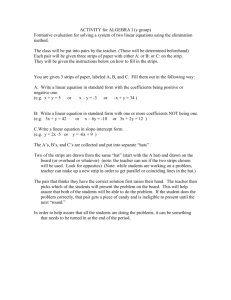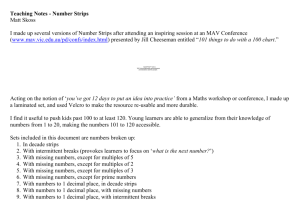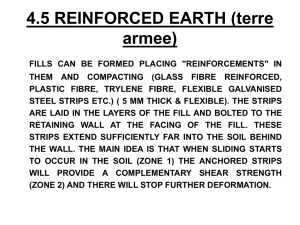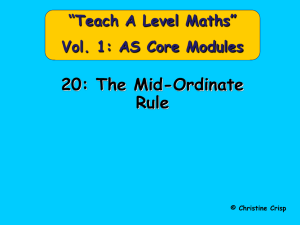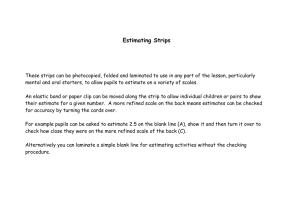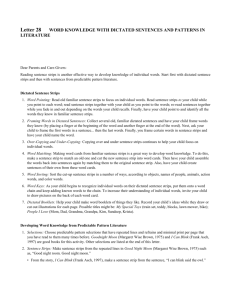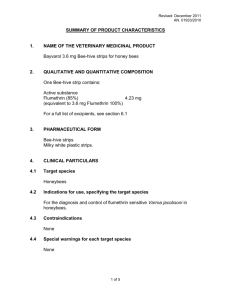C3 Numerical Methods
advertisement
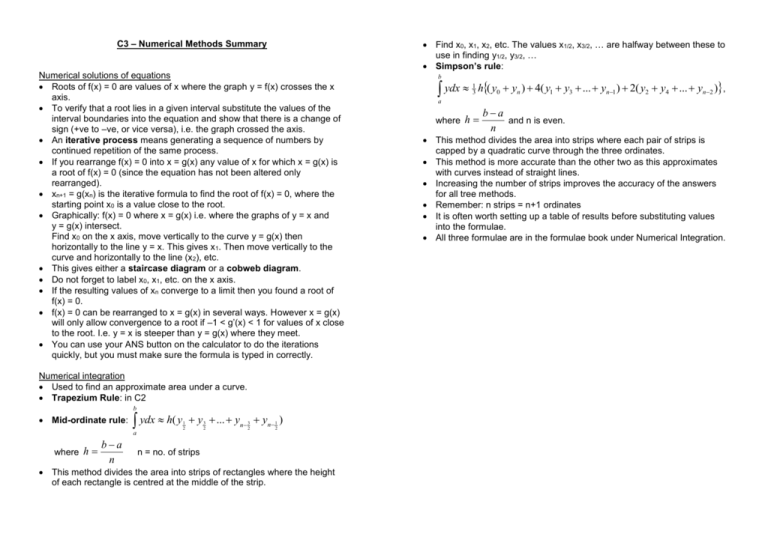
Find x0, x1, x2, etc. The values x1/2, x3/2, … are halfway between these to use in finding y1/2, y3/2, … Simpson’s rule: C3 – Numerical Methods Summary Numerical solutions of equations Roots of f(x) = 0 are values of x where the graph y = f(x) crosses the x axis. To verify that a root lies in a given interval substitute the values of the interval boundaries into the equation and show that there is a change of sign (+ve to –ve, or vice versa), i.e. the graph crossed the axis. An iterative process means generating a sequence of numbers by continued repetition of the same process. If you rearrange f(x) = 0 into x = g(x) any value of x for which x = g(x) is a root of f(x) = 0 (since the equation has not been altered only rearranged). xn+1 = g(xn) is the iterative formula to find the root of f(x) = 0, where the starting point x0 is a value close to the root. Graphically: f(x) = 0 where x = g(x) i.e. where the graphs of y = x and y = g(x) intersect. Find x0 on the x axis, move vertically to the curve y = g(x) then horizontally to the line y = x. This gives x1. Then move vertically to the curve and horizontally to the line (x2), etc. This gives either a staircase diagram or a cobweb diagram. Do not forget to label x0, x1, etc. on the x axis. If the resulting values of xn converge to a limit then you found a root of f(x) = 0. f(x) = 0 can be rearranged to x = g(x) in several ways. However x = g(x) will only allow convergence to a root if –1 < g’(x) < 1 for values of x close to the root. I.e. y = x is steeper than y = g(x) where they meet. You can use your ANS button on the calculator to do the iterations quickly, but you must make sure the formula is typed in correctly. Numerical integration Used to find an approximate area under a curve. Trapezium Rule: in C2 b Mid-ordinate rule: ydx h( y 1 2 y 3 ... yn 3 yn 1 ) 2 2 2 a where h ba n n = no. of strips This method divides the area into strips of rectangles where the height of each rectangle is centred at the middle of the strip. b ydx h( y 1 3 0 yn ) 4( y1 y3 ... yn1 ) 2( y2 y4 ... yn2 ), a where h ba and n is even. n This method divides the area into strips where each pair of strips is capped by a quadratic curve through the three ordinates. This method is more accurate than the other two as this approximates with curves instead of straight lines. Increasing the number of strips improves the accuracy of the answers for all tree methods. Remember: n strips = n+1 ordinates It is often worth setting up a table of results before substituting values into the formulae. All three formulae are in the formulae book under Numerical Integration.

